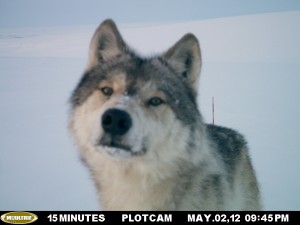Mug shot of a wolf, magpie names, goodbye Rat Island
July 2, 2012
6/7/2012
Sometimes you get lucky.
Ken Tape feels that way, after a time-lapse camera he set up in northern Alaska captured a full-frame portrait of a wolf. He shared the image with me, and, now, with you.
This spring, Tape, author of the book The Changing Arctic Landscape, set up 14 time-lapse cameras in Alaska north of the Arctic Circle. He programmed them to snap one picture every 15 minutes from April 24 to May 23. He wanted to record the great spring migrations of creatures large (caribou) and small (ptarmigan). Here’s what he had to say about serendipitously capturing a wolf’s mug shot:

“The most crazy aspect of it is that the camera was not motion-triggered (it doesn't even have that capability), but was instead simply shooting at 15 minute intervals!” Tape wrote in an email. “The wolf was either very curious and stuck around for awhile, or the camera got lucky on the timing . . . There are two faint red lights that blink every several seconds, so perhaps the wolf was curious about those, and of course the fact that (the camera is mounted on) a dark post jutting out of the white snow.”
The image of the wolf has enlivened Tape’s task of reviewing 80,000 images captured by his cameras this spring. The lone wolf was the only wolf captured on that particular camera, along with 103 caribou and 29 ptarmigan.
* * *
I wrote a while back about the northern invasion of black-billed magpies, leading with an anecdote about an elder in a southwest Alaska village who did not know a word for magpie, suggesting that the birds were not common there in the past. My friend Walkie Charles of the Alaska Native Language Center at the University of Alaska Fairbanks wrote me to say there are two words for magpie in the area: neqaiq refers to any food-stealing bird such as raven, gull, gray jay and magpie in the Iliamna Lake region. Qalerayak is the word for black-billed magpie throughout the entire area in which people speak Yup’ik.
* * *
Rat Island is no more. After more than 200 years with that name, the small island in the western Aleutians is now called Hawadax, pronounced “How-ah-thaa.” The island’s official name change came about because of a somewhat controversial project executed by biologists for the Alaska Maritime National Wildlife Refuge starting in fall 2008. Their goal was to kill every rat on the island using deadly grain pellets. Had they left one pregnant female rat on the Homer-size island, the project would have failed. The biologists’ goal was to return the island to the birds, as it was before a Japanese ship ran aground there in about 1780 and Norway rats swam to the island and thrived in part by eating the eggs of and young puffins, auklets and other birds that make their nests on the ground.
Though bald eagles and glaucous-wing gulls died during the operation, the biologists succeeded in removing all the rats from Rat Island, marking the first time rats have ever been removed from an Alaska island. Biologists have accomplished the feat on 300 other islands around the world, including New Zealand, atolls near Hawaii, and off the coast of California.
The re-naming of Rat Island is another example — after the removal of foxes from many Aleutian Islands and the subsequent recovery of the Aleutian Goose — of people working hard enough in a place remote enough to reset a place’s biological clock to a time before human arrival. That doesn’t happen many places in the world.
Since the late 1970s, the University of Alaska Fairbanks’ Geophysical Institute has provided this column free in cooperation with the UAF research community. Ned Rozell is a science writer for the Geophysical Institute.


